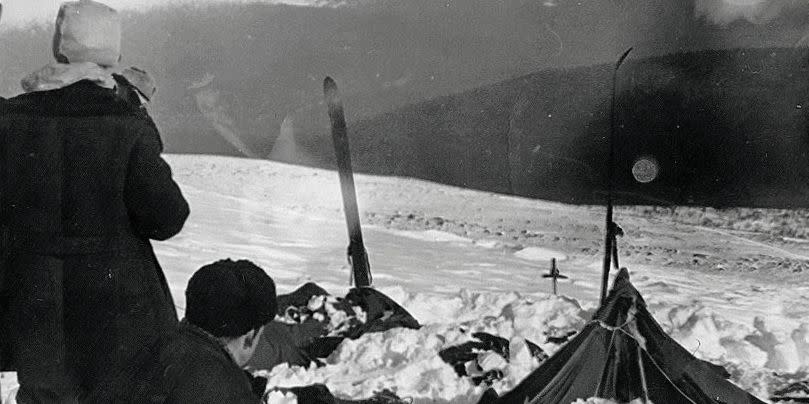How Did 9 Hikers Die in the Dyatlov Pass Incident? New Evidence Teases the Truth

The Dyatlov Pass Incident, a 1959 hiking tragedy in the remote Russian mountains, has been the source of untold theories.
Nine hikers were killed mysteriously, but new evidence points to military action as the cause of death.
Did a failed R-12 ballistic rocket launch result in a nitric acid fog, killing the hikers?
The potential truth of what really killed nine hikers in the remote Russian mountains in 1959 may be far stranger than the conspiracy theories—a yeti, anyone?—floated to date. New evidence released around the 64th anniversary of the tragic event points to failed Russian ballistic rocket launches and a floating nitric acid fog as the real culprit.
In a tragedy known as the Dyatlov Pass Incident, a group of nine students from the Ural Polytechnic Institute, led by Igor Dyatlov, planned a 16-day hike to cover 215 miles starting on February 2, 1959. But when the hikers didn’t check in, a search operation started on February 20. Searchers eventually found all nine bodies in their underwear near torn tents.
With no bodily injuries or signs of a struggle and all valuables nearby, investigators at the time believed all the hikers left the tent together and suddenly died. While a criminal case was opened, it quickly closed in May 1959. The official cause of death: exposure to the elements.
But that just wasn’t a clear enough explanation for the disaster, and for decades, many people have theorized about what actually truly caused the Dyatlov Pass Incident. Add in reports that the morgue was immediately sealed off, the KGB intervened (and even shipped off hikers’ organs for lab work), and regular procedures curtailed, and the truth hasn’t come easily.
A 2019 effort by the Office of the Prosecutor General in the Urals Federal District hoped to dispel the wildest of theories. It hasn’t seemed to help. The Office concluded that a slab avalanche forced the hikers to suddenly abandon their tent and run as much as 160 feet away. But because of the weather, they couldn’t return, and they froze to death.
That theory hasn’t held up, either. Last week, on the eve of the 64th anniversary of the tragedy, a Russian newsletter reported on a press conference that introduced a new theory—and this time, the relatives of the deceased hikers are on board. Researchers now say a failed Russian rocket launch caused a manmade disaster that struck the unaware hikers.
Vladislav Karelin, a 1959 searcher and now a researcher of the Dyatlov Pass Incident, says the idea of an avalanche simply doesn’t ring true. He remembers “stones stuck out” in the area, and there wasn’t enough snow to warrant an avalanche. What he does remember, though, was the entire search team seeing a fireball moving east to west in the area. Other witnesses around the same time said they saw a ball shooting south to north. More from Karelin, according to the Russian report:
“Some unidentified object flew from south to north, and then it changed direction and flew from east to west. Only some kind of winged unidentified object could change the trajectory of movement.”
Researcher Vadim Skibinsky believes the fireballs were the exhaust gases of a launched rocket. Not only was Russia carrying out missile launch tests throughout February 1959, but reports also say the snow melted around the camp, but not in other places nearby, leading to the manmade conclusion instead of a weather event.
The research team believes the launching—and a subsequent failure—of an R-12 liquid single-stage medium-range ballistic missile resulted in a nitric acid fog reaching the tent. Since testing happened within range of the mountains, and because nitric acid is a colorless, highly corrosive mineral acid used as an oxidizer in liquid-fueled rockets that can cause confusion and pain, the continued search for the truth about the Dyatlov Pass Incident may have moved well past exposure and avalanche directly into a fog.
But was it a fog of nitric acid?
You Might Also Like


